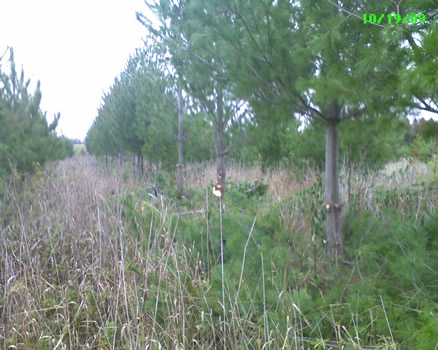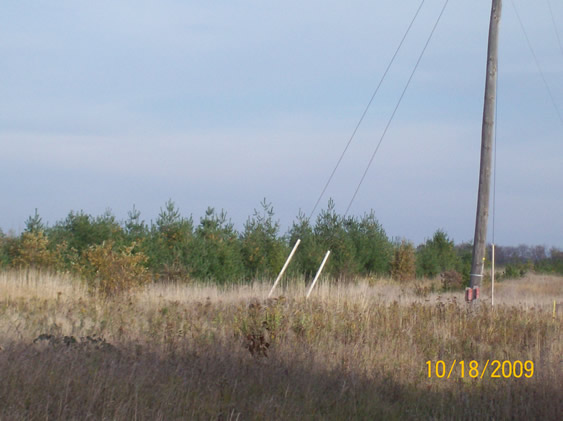 |
 |
| Home |
| TreeNut site |
| Cancer BLOG |
| Bookmarks |
| Popcorn |
| Can Crusher |
| Moth Man |
| Umpire |
| Power Line |
| Pin Ball |
| Wood Stoves |
All works within are ©2008 Stuart Baker. |
Letter to Northwestern Wisconsin Electric Co citing concerns with some of the information in the application to Wis Public Service Commission:
October 23, 2009
Mr. Dave Dahlberg
Northwestern Wisconsin Electric Company
PO Box 8
Grantsburg, WI 54840
Mr Dahlberg,
You and I have corresponded about the Milltown to Centuria power line project and I have discussed this in person with Dan Olson. After studying the application for permit (Docket # 4280 CE 106) from the PSC web site, I am still concerned that the nature of our farm business, and how it will be impacted by this line, have not been accurately represented in this proposal. And as a result the PSC cannot properly weigh the relative advantages and impacts in deciding between the primary and alternative routes.
Appendix A Figure 5 - page 4 The classification of our land (that which is effected by this ROW) is listed as "OF" (Old Field). Based on correspondence with you and discussions with Dan Olsen, a more accurate classification would be "C", or at least "F" (please see enclosed pictures of this site). Even the aerial photographs clearly show the definite rows of our forest plantation. This is definitely not abandoned farmland, inactive, or fallow field.
Many sections of the Technical Support Document specify strategies for minimizing impact on ‘agricultural’ production and for either compensation for or restoration of crops affected by this construction. Section 2.4.5 defines various agricultural activities but nowhere is there a section for forest agriculture (Silviculture). Only lands that are being used in production of annual crops (corn, beans, alfalfa, wheat, etc.) can qualify for consideration. And the only criteria for agricultural production that is listed, is “evidence of recent tillage”. Agricultural land that is being managed for timber production only needs to be cultivated once per crop cycle (same as any other crop). And for most of this land the crop cycle (and cultivation) began 15 years ago.
Appendix A, Figure 4 - Page 1 of 1 the Existing Land Use is listed as "W8" which doesn't have a definition. What is W8? I believe this would be more accurately classified as "G5" or "G5M" for the following:
- In 1995 we switched this land from producing corn (avg. 150 Bushels per acre) to producing 'high value saw timber' as defined in our Stewardship Forestry Plan when, in 1999, we enrolled this land under the Managed Forest Law with the Wisconsin Department of Natural Resources. This was a deliberate and considered decision to switch production on this land from an annual (or perennial) crop to a crop that takes between 20 to 300 years to mature for market.
- Forest production is a process that doesn't necessarily begin with mature trees. For the past 15 years we have been managing this land to establish a producing forest. This has required a significant investment in time and money for:
- Field preparation for planting - mowing, tilling, and herbicide application.
- Planting (and replanting) trees either from seed or transplanting nursery stock. Every year we have transplanted between 2,000 and 14,000 seedlings.
- Release: selective mowing, tilling, and herbicides to hold down grass and weeds to give the young transplants a start. As well as measures to discourage dear browse and rodent damage.
- Pruning and thinning: Pruning white pine to prevent and treat for White Pine Blister Rust. Thinning and selection of best species and most robust producer trees.
- The first ten years of a trees life provide very little return on investment. There is very little net wood production per tree as the tree works to establish a root system and grow above weeds and grasses that compete for food and water. After ten years they begin to grow in diameter and height and begin to ‘lay on’ marketable wood. This net production increases each year as the tree grows in height and diameter for another 50 to 300 years (depending on species.) So if you cut down a 20 year old tree you not only loose the past 20 years of wood production but you loose the last 20 years of building up to that level (rate of production). Basically you not only loose the product, you loose the whole factory. And that factory will take another 20 years to rebuild.
Finally, when I discussed this with Dan Olsen, he said that transmission companies have been very successful at working with land owners on issues of this sort. He reassured me that this history of cooperation would continue. I am enclosing an article from the Wisconsin State Journal that has caused me to seriously question a power company’s ability to continue to make these allowances. The article concludes; “The sometimes decades-old easements landowners signed to give utility companies access to their land could be challenged in court … but there is no formal appeals process set up for landowners who object to trimming practices.” This means that now is probably the only time I have any chance to control what happens to our lumber producing trees that will be lost to the expanded ROW needed for this line (described in previous correspondence).
Most of our land that is affected by this power line is enrolled in Managed Forest Law and some is in CRP (Conservation Reserve Program) so we are restricted to what crops we can produce on our land. We're already loosing significant cropland to ROW for the existing power line. We can't afford to loose more. I'm not trying to say that this power line isn't needed or shouldn't be built - I don't know the answer to that. I just want to make sure all the issues involved in selecting the best route are fairly presented and properly weighed.
Thank you
Stuart Baker
Parcel ID #: 44000050000
Attachments:
- Pictures of land affected by this ROW
- Article from Wisconsin State Journal: “Landowners' trees fall amid new approach on power lines.”
A few pictures of the fields that were classified as “Old Field”:
View from 180th along the existing ROW (Right Of Way)- outer two rows of this plantation will be lost to the new (wider) ROW
Tree trimming – white pine for control and prevention of blister rust.
Thinning out undesirable brush and trees
Webmaster: Stuart Baker
Email Stuart

